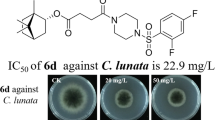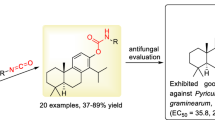Abstract
A series of ten chalcones (7a–j) and five new dihydrochromane–chalcone hybrids (7k–o) were synthesized and identified using spectroscopic techniques (IR, NMR, and MS). All compounds were evaluated in vitro against the B. cinerea and M. fructicola phytopathogens that affect a wide range of crops of commercial interest. All compounds were tested against both phytopathogens using the mycelial growth inhibition test, and it was found that two and five compounds had similar activity to that of the positive control for B. cinerea (7a = 43.9, 7c = 45.5, and Captan®= 24.8 µg/mL) and M. fructicola (7a = 48.5, 7d = 78.2, 7e = 56.1, 7f = 51.8, 7n = 63.2, and Mystic®= 21.6 µg/mL), respectively. To understand the key chalcone structural features for the antifungal activity on B. cinerea and M. fructicola, we developed structure–activity models with good statistical values (r2 and q2 higher than 0.8). For B. cinerea, the hydrogen bonding donor and acceptor and the atomic charge on C5 modulate the mycelial growth inhibition activity. In contrast, dipole moment and atomic charge on C1′ and the carbonyl carbon modify the inhibition activity for M. fructicola. These results allow the design of other compounds with activities superior to those of the compounds obtained in this study.
Graphic Abstract






Similar content being viewed by others
References
Hou D, Yan C, Liu H, Ge X, Xu W, Tian P (2010) Berberine as a natural compound inhibits the development of brown rot fungus Monilinia fructicola. Crop Prot 29(9):979–984
Romanazzi G, Feliziani E (2014) Botrytis cinerea (gray mold). In: Bautista-Baños S (ed) Postharvest decay, control strategies. Academic Press, New York, pp 131–146
Martini C, Mari M (2014) Monilinia fructicola, Monilinialaxa (monilinia rot, brown rot). In: Bautista-Baños S (ed) Postharvest decay, control strategies. Academic Press, New York, pp 233–265
Williamson B, Tudzynsk B, Tudzynski P, van Kan JAL (2007) Botrytis cinerea: the cause of grey mould disease. Mol Plant Pathol 8(5):561–580. https://doi.org/10.1111/J.1364-3703.2007.00417.X
Rosslenbroich HJ, Stuebler D (2000) Botrytis cinerea - history of chemical control and novel fungicides for its management. Crop Prot 19(8–10):557–561. https://doi.org/10.1016/S0261-2194(00)00072-7
Panebianco A, Castello I, Cirvilleri G, Perrone G, Epifani F, Ferrara M, Polizzi G, Walters D, Vitale A (2015) Detection of Botrytis cinerea field isolates with multiple fungicide resistance from table grape in Sicily. Crop Prot 77:65–73
Soylu EM, Kurt S, Soylu S (2010) In vitro and in vivo antifungal activities of the essential oils of various plants against tomato grey mould disease agent Botrytis cinerea. Int J Food Microbiol 143(3):183–189. https://doi.org/10.1016/j.ijfoodmicro.2010.08.015
Kumar R, Sharma P, Shard A, Tewary D, Nadda G, Sinha A (2012) Chalcones as promising pesticidal agents against diamondback moth (Plutellaxylostella): microwave-assisted synthesis and structure–activity relationship. Med Chem Res 21(6):922–931
Kocyigit-Kaymakcioglu B, Beyhan N, Tabanca N, Ali A, Wedge DE, Duke SO, Bernier UR, Khan IA (2015) Discovery and structure activity relationships of 2-pyrazolines derived from chalcones from a pest management perspective. Med Chem Res 24(10):3632–3644. https://doi.org/10.1007/s00044-015-1415-8
Satyavani S, Kanjilal S, Rao M, Prasad R, Murthy U (2015) Synthesis and mosquito larvicidal activity of furanochalcones and furanoflavonoids analogous to karanjin. Med Chem Res 24(2):842–850
Zheng Y, Wang X, Gao S, Ma M, Ren G, Liu H, Chen X (2015) Synthesis and antifungal activity of chalcone derivatives. Nat Prod Res 29(19):1804–1810. https://doi.org/10.1080/14786419.2015.1007973
Cotoras M, Garcia C, Lagos C, Folch C, Mendoza L (2001) Antifungal activity on Botrytis cinerea of flavonoids and diterpenoids isolated from the surface of Pseudognaphalium spp. Bol Soc Chil Quim 46(4):433–440
Agrawal A (2011) Pharmacological activities of flavonoids: a review. Int J Pharm Sci Nanotech 4(2):1394–1398
Yadav VR, Prasad S, Sung B, Aggarwal BB (2011) The role of chalcones in suppression of NF-kappaB-mediated inflammation and cancer. Int Immunopharmacol 11(3):295–309. https://doi.org/10.1016/j.intimp.2010.12.006
Pilatova M, Varinska L, Perjesi P, Sarissky M, Mirossay L, Solar P, Ostro A, Mojzis J (2010) In vitro antiproliferative and antiangiogenic effects of synthetic chalcone analogues. Toxicol Int 24(5):1347–1355. https://doi.org/10.1016/j.tiv.2010.04.013
Luo Y, Song R, Li Y, Zhang S, Liu ZJ, Fu J, Zhu HL (2012) Design, synthesis, and biological evaluation of chalcone oxime derivatives as potential immunosuppressive agents. Bioorg Med Chem Lett 22(9):3039–3043. https://doi.org/10.1016/j.bmcl.2012.03.080
Kamal A, Prabhakar S, Ramaiah MJ, Reddy PV, Reddy CR, Mallareddy A, Shankaraiah N, Reddy TLN, Pushpavalli SNCVL, Pal-Bhadra M (2011) Synthesis and anticancer activity of chalcone-pyrrolobenzodiazepine conjugates linked via 1,2,3-triazole ring side-armed with alkane spacers. Eur J Med Chem 46(9):3820–3831. https://doi.org/10.1016/j.ejmech.2011.05.050
Kocyigit UM, Budak Y, Eliguzel F, Taslimi P, Kilic D, Gulcin I, Ceylan M (2017) Synthesis and carbonic anhydrase inhibition of tetrabromo chalcone derivatives. Arch Pharm 350(12) e1700198
Kocyigit UM, Budak Y, Gurdere MB, Erturk F, Yencilek B, Taslimi P, Gulcin I, Ceylan M (2018) Synthesis of chalcone-imide derivatives and investigation of their anticancer and antimicrobial activities, carbonic anhydrase and acetylcholinesterase enzymes inhibition profiles. Arch Physiol Biochem 124(1):61–68. https://doi.org/10.1080/13813455.2017.1360914
Burmaoglu S, Yilmaz AO, Polat MF, Kaya R, Gulcin I, Algul O (2019) Synthesis and biological evaluation of novel tris-chalcones as potent carbonic anhydrase, acetylcholinesterase, butyrylcholinesterase and alpha-glycosidase inhibitors. Bioorg Chem 85:191–197. https://doi.org/10.1016/j.bioorg.2018.12.035
Otero E, Vergara S, Robledo SM, Cardona W, Carda M, Velez ID, Rojas C, Otalvaro F (2014) Synthesis, leishmanicidal and cytotoxic activity of triclosan-chalcone, triclosan-chromone and triclosan-coumarin hybrids. Molecules 19(9):13251–13266. https://doi.org/10.3390/molecules190913251
Singh G, Arora A, Mangat SS, Rani S, Kaur H, Goyal K, Sehgal R, Maurya IK, Tewari R, Choquesillo-Lazarte D, Sahoo S, Kaur N (2016) Design, synthesis and biological evaluation of chalconyl blended triazole allied organosilatranes as giardicidal and trichomonacidal agents. Eur J Med Chem 108:287–300. https://doi.org/10.1016/j.ejmech.2015.11.029
Romano E, Raschi AB, Gonzalez AM, Jaime G, Fortuna MA, Hernandez LR, Bach H, Benavente AM (2011) Phytotoxic activities of (2R)-6-hydroxytremetone. Plant Physiol Bioch 49(6):671–675. https://doi.org/10.1016/j.plaphy.2011.02.014
Jeffrey CS, Leonard MD, Glassmire AE, Dodson CD, Richards LA, Kato MJ, Dyer LA (2014) Antiherbivore prenylated benzoic acid derivatives from piper kelleyi. J Nat Prod 77(1):148–153. https://doi.org/10.1021/np400886s
Sanz MA, Voigt T, Waldmann H (2006) Enantioselective catalysis on the solid phase: synthesis of natural product-derived tetrahydropyrans employing the enantioselective oxa-Diels–Alder reaction. Adv Synth Catal 348(12–13):1511–1515. https://doi.org/10.1002/adsc.200606026
Ghosh AK, Anderson DD (2011) Tetrahydrofuran, tetrahydropyran, triazoles and related heterocyclic derivatives as HIV protease inhibitors. Future Med Chem 3(9):1181–1197. https://doi.org/10.4155/Fmc.11.68
Thompson CF, Jamison TF, Jacobsen EN (2001) FR901464: total synthesis, proof of structure, and evaluation of synthetic analogues. J Am Chem Soc 123(41):9974–9983
Santander J, Otto C, Lowry D, Cuellar M, Mellado M, Salas C, Rothhammer F (2015) Specific gram-positive antibacterial activity of 4-hydroxy-3-(3-methyl-2-butenyl) Acetophenone Isolated from Senecio graveolens. Br Microbiol Res J 5(2):94–106
Narender T, Reddy KP, Kumar B (2008) BF(3)center dot OEt(2) mediated regioselective deacetylation of polyacetoxyacetophenones and its application in the synthesis of natural products. Tetrahedron Lett 49(28):4409–4415. https://doi.org/10.1016/j.tetlet.2008.05.020
Lizarraga E, Gil DM, Echeverria GA, Piro OE, Catalan CAN, Ben Altabef A (2014) Synthesis, crystal structure, conformational and vibrational properties of 6-acetyl-2,2-dimethyl-chromane. Spectrochim Acta A 127:74–84. https://doi.org/10.1016/j.saa.2014.02.035
Batovska D, Parushev S, Slavova A, Bankova V, Tsvetkova I, Ninova M, Najdenski H (2007) Study on the substituents’ effects of a series of synthetic chalcones against the yeast Candida albicans. Eur J Med Chem 42(1):87–92. https://doi.org/10.1016/j.ejmech.2006.08.012
Ritter M, Martins RM, Rosa SA, Malavolta JL, Lund RG, Flores AFC, Pereira CMP (2015) Green synthesis of chalcones and microbiological evaluation. J Brazil Chem Soc 26(6):1201–1210. https://doi.org/10.5935/0103-5053.20150084
Zhang LL, Wang AQ, Wang WT, Huang YQ, Liu XY, Miao S, Liu JY, Zhang T (2015) Co–N–C catalyst for C–C coupling reactions: on the catalytic performance and active sites. Acs Catal 5(11):6563–6572. https://doi.org/10.1021/acscatal.5b01223
Mellado M, Madrid A, Martinez U, Mella J, Salas CO, Cuellar M (2018) Hansch’s analysis application to chalcone synthesis by Claisen-Schmidt reaction based in DFT methodology. Chem Pap 72(3):703–709. https://doi.org/10.1007/s11696-017-0316-3
Mellado M, Madrid A, Reyna M, Weinstein-Oppenheimer C, Mella J, Salas CO, Sanchez E, Cuellar M (2018) Synthesis of chalcones with antiproliferative activity on the SH-SY5Y neuroblastoma cell line: quantitative structure-activity relationship models. Med Chem Res 27(11–12):2414–2425. https://doi.org/10.1007/s00044-018-2245-2
Gulcin I, Tel AZ, Kirecci E (2008) Antioxidant, antimicrobial, antifungal, and antiradical activities of Cyclotrichium niveum (Boiss.) Manden and Scheng. Int J Food Prop 11(2):450–471. https://doi.org/10.1080/10942910701567364
Gulcin I, Kirecci E, Akkemik E, Topal F, Hisar O (2010) Antioxidant and antimicrobial activities of an aquatic plant: duckweed (Lemna minor L.). Turk J Biol 34:175–188. https://doi.org/10.3906/biy-0806-7
Zhang J, Peng JF, Bai YB, Wang P, Wang T, Gao JM, Zhang ZT (2016) Synthesis of pyrazolo[1,5-a]pyrimidine derivatives and their antifungal activities against phytopathogenic fungi in vitro. Mol Divers 20(4):887–896. https://doi.org/10.1007/s11030-016-9690-y
Zhang J, Peng JF, Wang T, Kang Y, Jing SS, Zhang ZT (2017) Synthesis and biological evaluation of arylpyrazoles as fungicides against phytopathogenic fungi. Mol Divers 21(2):317–323. https://doi.org/10.1007/s11030-017-9727-x
Cotoras M, Mendoza L, Munoz A, Yanez K, Castro P, Aguirre M (2011) Fungitoxicity against Botrytis cinerea of a Flavonoid Isolated from Pseudognaphalium robustum. Molecules 16(5):3885–3895. https://doi.org/10.3390/molecules16053885
Verma RP, Hansch C (2005) An approach toward the problem of outliers in QSAR. Bioorgan Med Chem 13(15):4597–4621. https://doi.org/10.1016/j.bme.2005.05.002
Mellado M, Madrid A, Martínez U, Mella J, Salas C, Cuellar M (2017) Hansch’s analysis application to chalcone synthesis by Claisen–Schmidt reaction based in DFT methodology. Chem Pap 10:15–20. https://doi.org/10.1007/s11696-017-0316-3
Fujita T, Nishioka T, Nakajima M (1977) Hydrogen-bonding parameter and its significance in quantitative structure-activity studies. J Med Chem 20(8):1071–1081. https://doi.org/10.1021/Jm00218a017
Raevsky OA, Skvortsov VS (2005) Quantifying hydrogen bonding in QSAR and molecular modeling. SAR QSAR Environ Res 16(3):287–300. https://doi.org/10.1080/10659360500036893
Chan K, Jensen NS, Silber PM, O’Brien PJ (2007) Structure-activity relationships for halobenzene induced cytotoxicity in rat and human hepatocytes. Chem Biol Interact 165(3):165–174. https://doi.org/10.1016/j.cbi.2006.12.004
Stouch TR, Gudmundsson A (2002) Progress in understanding the structure-activity relationships of P-glycoprotein. Adv Drug Deliver Rev 54(3):315–328
Sparks TC, Crouse GD, Durst G (2001) Natural products as insecticides: the biology, biochemistry, and quantitative structure-activity relationships of spinosyns and spinosoids. Pest Manag Sci 57(10):896–905. https://doi.org/10.1002/Ps.358
Maydt D, De Spirt S, Muschelknautz C, Stahl W, Muller TJ (2013) Chemical reactivity and biological activity of chalcones and other alpha, beta-unsaturated carbonyl compounds. Xenobiotica; the fate of foreign compounds in biological systems 43(8):711–718. https://doi.org/10.3109/00498254.2012.754112
Soto M, Espinoza L, Chavez MI, Diaz K, Olea AF, Taborga L (2016) Synthesis of new hydrated geranylphenols and in vitro antifungal activity against Botrytis cinerea. Int J Mol Sci 17(6):840. https://doi.org/10.3390/ijms17060840
Hou Z, Yang R, Zhang C, Zhu LF, Miao F, Yang XJ, Zhou L (2013) 2-(substituted phenyl)-3,4-dihydroisoquinolin-2-iums as novel antifungal lead compounds: biological evaluation and structure-activity relationships. Molecules 18(9):10413–10424. https://doi.org/10.3390/molecules180910413
Acknowledgements
The authors thank Vicerectoria de Investigación y Estudios Avanzados of Pontificia Universidad Católica de Valparaíso, and Dr. Carlos Echiburu-Chau for the collection and identification of S. graveolens.
Funding
This research was funded by CONICYT Programa Formación de Capital Humano Avanzado 21130456, Postdoctoral Fondecyt grant 3180408, and Vicerectoria de Investigación y Estudios Avanzados of Pontificia Universidad Católica de Valparaíso VRIEA-PUCV “37.0/2017”.
Author information
Authors and Affiliations
Contributions
KD was involved in design, evaluation, interpretation and discussion of biological activity, and manuscript redaction; AM wrote and proofread the manuscript; LE and MC were involved in spectroscopic analysis and discussion. JM was involved in 2D-QSAR models discussion; ECW isolated and identified M. fructicola; MM synthesized and isolated all compounds, was involved in spectroscopic analysis and discussion and development and analysis of 2D-QSAR models, and wrote and proofread the manuscript.
Corresponding authors
Ethics declarations
Conflicts of interest
The authors declare no conflict of interest.
Additional information
Publisher's Note
Springer Nature remains neutral with regard to jurisdictional claims in published maps and institutional affiliations.
Electronic supplementary material
Below is the link to the electronic supplementary material.
Rights and permissions
About this article
Cite this article
Mellado, M., Espinoza, L., Madrid, A. et al. Design, synthesis, antifungal activity, and structure–activity relationship studies of chalcones and hybrid dihydrochromane–chalcones. Mol Divers 24, 603–615 (2020). https://doi.org/10.1007/s11030-019-09967-y
Received:
Accepted:
Published:
Issue Date:
DOI: https://doi.org/10.1007/s11030-019-09967-y




